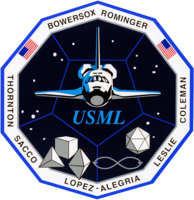STS-73
 | |
| Dane misji | |
| Indeks COSPAR | 1995-056A |
|---|---|
| Zaangażowani | |
| Oznaczenie kodowe | STS-73 |
| Pojazd | |
| Wahadłowiec | Columbia |
| Załoga | |
 Od lewej: Catherine Coleman, Albert Sacco, Kenneth Bowersox, Kent Rominger, Fred Leslie, Michael Lopez-Alegria, Kathryn Thornton | |
| Dowódca | Kenneth Bowersox |
| Start | |
| Miejsce startu | Stany Zjednoczone, KSC, LC39-B |
| Początek misji | 20 października 1995 13:53:00 UTC[1] |
| Orbita okołoziemska | |
| Apogeum | 278 km |
| Lądowanie | |
| Miejsce lądowania | KSC, Pas startowy 33 |
| Lądowanie | 5 listopada 1995 11:45:21 UTC[1] |
| Czas trwania misji | 15 dni, 21 godz., 52 min, 21 sek[1] |
| Przebyta odległość | 10 621 670 km[2] |
| Liczba okrążeń Ziemi | 255[1][3] |
| Program lotów wahadłowców | |
STS-73 (ang. Space Transportation System) – osiemnasta misja amerykańskiego wahadłowca kosmicznego Columbia i siedemdziesiąta druga programu lotów wahadłowców[4].
Załoga
- źródło[4]
- Kenneth Bowersox (3)*, dowódca (CDR)
- Kent Rominger (1), pilot (PLT)
- Kathryn Thornton (4), dowódca ładunku (MS2)
- Catherine „Cady” Coleman Ph.D (1), specjalista misji (MS1)
- Michael Lopez-Alegria (1), specjalista misji (MS3)
- Fred Leslie Ph.D (1), specjalista ładunku (PS1)
- Albert Sacco (1), specjalista ładunku (PS2)
Załoga rezerwowa
- David Matthiesen (0), specjalista ładunku
- Glynn Holt (0), specjalista ładunku
- *(liczba w nawiasie oznacza liczbę lotów odbytych przez każdego z astronautów)
Parametry misji
- źródło[2]
- Masa:
- startowa orbitera: 116 646 kg
- lądującego orbitera: 104 398 kg
- ładunku: 15 250 kg
- Perygeum: 241 km
- Apogeum: 241 km
- Inklinacja: 39,0°
- Okres orbitalny: 89,7 min
Cel misji
Prowadzenie eksperymentów naukowych na pokładzie laboratorium Spacelab USML-2 (United States Microgravity Laboratory)[4].
Zobacz też
Przypisy
- ↑ a b c d Spaceflight mission report: STS-73 (ang.). Spacefacts. [dostęp 2017-07-25].
- ↑ a b Mark Wade: STS-73 (ang.). W: Encyclopedia Astronautica [on-line]. [dostęp 2017-07-25].
- ↑ podsumowanie misji STS-73 na stronie KSC (ang.)
- ↑ a b c Tomáš Přibyl: Dzień, w którym nie wróciła COLUMBIA. Bielsko-Biała: Wydawnictwo >DEBIT<, 2003, s. 170. ISBN 83-7167-224-1.
Linki zewnętrzne
- podsumowanie misji STS-73 na stronie KSC (ang.)
- Mark Wade: STS-73 (ang.). W: Encyclopedia Astronautica [on-line]. [dostęp 2017-07-25].
- Spaceflight mission report: STS-73 (ang.). Spacefacts. [dostęp 2017-07-25].
Media użyte na tej stronie
The flag of Navassa Island is simply the United States flag. It does not have a "local" flag or "unofficial" flag; it is an uninhabited island. The version with a profile view was based on Flags of the World and as a fictional design has no status warranting a place on any Wiki. It was made up by a random person with no connection to the island, it has never flown on the island, and it has never received any sort of recognition or validation by any authority. The person quoted on that page has no authority to bestow a flag, "unofficial" or otherwise, on the island.
The crew patch of STS-73, the second flight of the United States Microgravity Laboratory (USML-2), depicts the Space Shuttle Columbia in the vastness of space. In the foreground are the classic regular polyhedrons that were investigated by Plato and later Euclid. The Pythagoreans were also fascinated by the symmetrical three-dimensional objects whose sides are the same regular polygon. The tetrahedron, the cube, the octahedron, and the icosahedron were each associated with the Natural Elements of that time: fire (on this mission represented as combustion science); Earth (crystallography), air and water (fluid physics). An additional icon shown as the infinity symbol was added to further convey the discipline of fluid mechanics. The shape of the emblem represents a fifth polyhedron, a dodecahedron, which the Pythagoreans thought corresponded to a fifth element that represented the cosmos.
Crew of the Space Shuttle mission STS-73. NASA photo STS073-S-002 taken July 1995. :On the front row, left to right, are Albert Sacco Jr., payload specialist; Kent V. Rominger, pilot; Michael E. Lopez-Alegria, mission specialist. On the back row are, left to right, Catherine G. Coleman, mission specialist; Kenneth D. Bowersox, commander; Fred W. Leslie, payload specialist; and Kathryn C. Thornton, payload commander.


